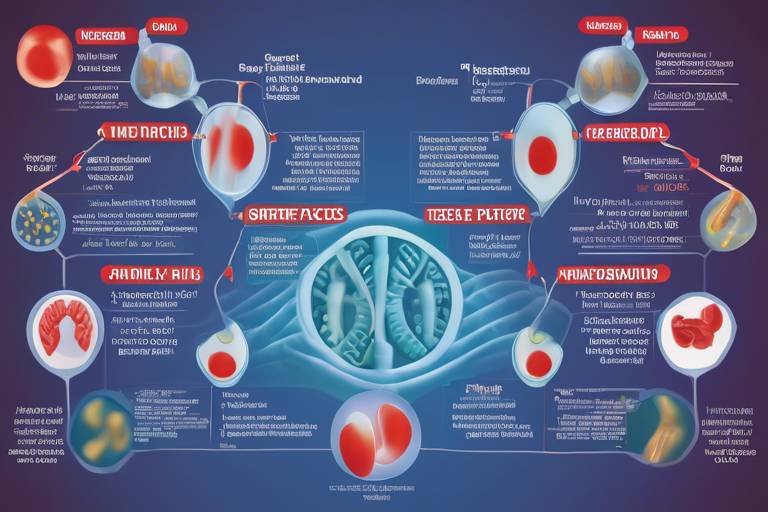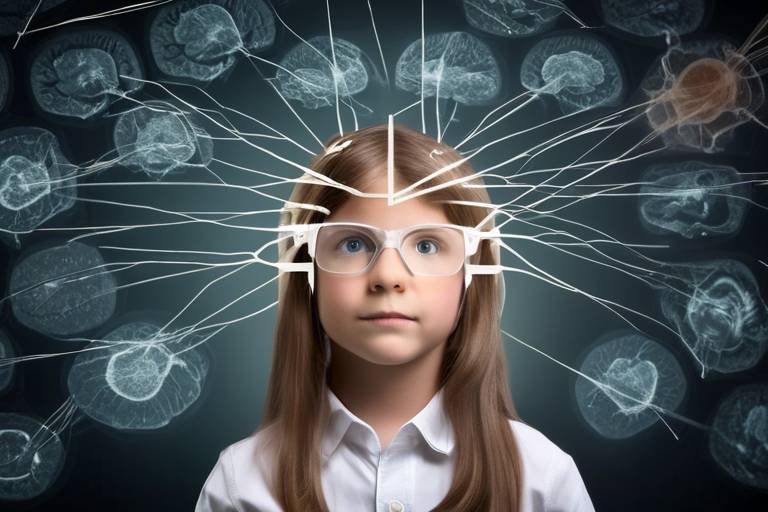How Recent Discoveries are Changing Our Understanding of Pain
Have you ever wondered why pain can feel so different from one person to another? It's a question that has puzzled scientists, doctors, and patients alike for centuries. Recent discoveries have begun to peel back the layers of this complex phenomenon, revealing that pain is not just a simple reaction to injury but a multifaceted experience influenced by a myriad of biological, psychological, and environmental factors. This evolving understanding is not only reshaping how we perceive pain but also how we approach its treatment.
Traditionally, pain was viewed through a rather narrow lens, often categorized simply as acute or chronic. However, emerging research has broadened this perspective significantly. For instance, scientists are now exploring the intricate biological pathways that contribute to pain perception, including the role of the nervous system and the brain's processing mechanisms. This new knowledge is paving the way for innovative treatment strategies that aim to target the root causes of pain rather than merely alleviating its symptoms.
One particularly fascinating area of study is the relationship between neurological pathways and pain. Recent findings suggest that pain is not just a direct response to physical harm; rather, it can be influenced by emotional and psychological states. This means that factors such as stress, anxiety, and even past experiences can amplify or diminish the sensation of pain. Imagine your brain as a complex orchestra, where each instrument represents a different factor influencing your pain experience. When one instrument plays too loudly—say, anxiety—the entire symphony of pain can become overwhelming.
This evolving understanding of pain has significant implications for chronic pain management. Millions of people worldwide suffer from conditions that lead to persistent pain, often with limited relief from conventional treatments. By recognizing the multifaceted nature of pain, healthcare providers are beginning to adopt more holistic approaches that consider both the physical and psychological aspects of pain. This shift is crucial in developing effective strategies tailored to individual patients.
As we delve deeper into the mechanisms of pain, we also uncover the importance of inflammation in pain perception. Recent studies have shown that inflammatory processes can significantly contribute to the sensation of pain. Targeting these inflammatory pathways may offer new therapeutic options for those suffering from various pain conditions. Think of inflammation as a fire alarm that goes off even when there's no fire; by addressing the alarm system, we can potentially reduce the unnecessary pain response.
Moreover, genetic factors play a critical role in how individuals experience pain. Research indicates that some people may have a genetic predisposition to higher pain sensitivity, affecting their response to treatments. This understanding opens the door to personalized medicine, where treatments can be tailored based on a patient’s unique genetic makeup. Imagine being able to customize pain management strategies just like you would tailor a suit—perfectly fitted to your needs.
In summary, the landscape of pain research is rapidly evolving, with recent discoveries challenging long-held beliefs and opening new avenues for exploration. By understanding pain as a complex interplay of biological, psychological, and environmental factors, we can develop more effective and personalized treatment strategies that hold the promise of improving the quality of life for millions suffering from chronic pain.
- What are the main types of pain? Pain is generally classified into two categories: acute pain, which is short-term and often related to injury, and chronic pain, which persists over time and can be more complex.
- How does psychology affect pain perception? Psychological factors such as stress, anxiety, and depression can exacerbate pain sensations, making integrated treatment approaches essential.
- What role does inflammation play in pain? Inflammation can heighten pain perception, and targeting inflammatory pathways may provide new therapeutic options for pain relief.

Understanding Pain Mechanisms
This article explores groundbreaking research and findings that are reshaping our perception of pain, its mechanisms, and treatment approaches, providing insights into chronic pain management and innovative therapies.
Recent studies have unveiled a complex web of biological and neurological mechanisms that underlie pain, challenging our traditional views and opening exciting new avenues for research. Pain is not merely a physical sensation; it is a multifaceted experience influenced by a myriad of factors that intertwine in fascinating ways. When we experience pain, it's as if our body is sending out a distress signal, but the pathways this signal travels are far from straightforward. Instead, they involve a sophisticated interplay between the nervous system, the immune system, and even our emotional state.
At the core of our understanding lies the nervous system, which can be thought of as an intricate communication network. This network transmits pain signals from the site of injury through various pathways to the brain, where the signals are interpreted. However, recent research has shown that this process is not a simple relay; it's more like a complex symphony, where each instrument plays a role in how we perceive pain. For instance, the presence of certain neurotransmitters can amplify or dampen the pain signals, altering our experience significantly.
Moreover, pain is not just a physical response; it is deeply intertwined with our psychological state. Stress and anxiety can heighten the sensation of pain, making it feel more intense. This connection leads to the idea that pain management should not solely focus on physical treatments but also consider mental health. In fact, studies suggest that addressing psychological factors can improve treatment outcomes significantly.
To further illustrate the complexity of pain mechanisms, consider the following aspects:
- Peripheral Sensitization: This occurs when the nerve endings become more sensitive after an injury, leading to heightened pain responses.
- Centrally Mediated Pain: Sometimes, the brain itself can misinterpret signals, leading to pain even when there is no physical cause.
- Genetic Factors: Individual genetic makeup can influence how we perceive pain, making some people more susceptible to chronic pain conditions.
As we delve deeper into these mechanisms, we uncover the potential for innovative treatments that target specific pathways involved in pain perception. For instance, researchers are exploring how modulating certain neurotransmitters can offer relief for those suffering from chronic pain. This shift in understanding is crucial, as it opens doors to more personalized approaches in pain management, allowing for treatments tailored to individual needs.
In summary, understanding the mechanisms of pain is akin to deciphering a complex code. Each discovery adds a new layer of knowledge, reshaping our approach to treatment and offering hope to millions who suffer from chronic pain. As we continue to explore these intricate pathways, we move closer to unlocking the secrets of pain, paving the way for more effective and compassionate care.
| Question | Answer |
|---|---|
| What are the main types of pain? | Pain can be categorized into acute and chronic pain, with chronic pain being ongoing and often resistant to standard treatments. |
| How does stress affect pain perception? | Stress can heighten pain sensitivity, making the experience of pain more intense and difficult to manage. |
| Are there genetic factors that influence pain sensitivity? | Yes, genetic predispositions can significantly affect how individuals experience and respond to pain. |

Chronic Pain Conditions
Chronic pain is a pervasive issue that affects millions of individuals around the globe. It’s not just a fleeting discomfort; it’s a persistent condition that can significantly diminish quality of life. Imagine waking up every day with a dull ache that refuses to go away, or sharp stabbing sensations that interrupt your daily activities. This is the reality for many who suffer from chronic pain conditions. Understanding the complexities behind these conditions is essential for developing effective treatment strategies.
Chronic pain can stem from a variety of sources, including injuries, surgeries, or even conditions like arthritis. However, it’s crucial to recognize that pain is not solely a physical phenomenon. Psychological factors, such as stress and anxiety, can exacerbate the experience of pain, creating a vicious cycle that is difficult to break. This interplay between the mind and body underscores the importance of a comprehensive approach to pain management.
To put things into perspective, let’s look at some common chronic pain conditions:
- Fibromyalgia: A condition characterized by widespread musculoskeletal pain, fatigue, and tenderness in localized areas.
- Osteoarthritis: A degenerative joint disease that results in the breakdown of cartilage, leading to pain and stiffness.
- Chronic Back Pain: Often caused by injuries, poor posture, or degenerative conditions, this type of pain can be debilitating.
- Migraine: A neurological condition that can cause severe headaches, often accompanied by nausea and sensitivity to light.
Each of these conditions has unique characteristics and challenges, making it essential for healthcare providers to tailor treatment plans to individual needs. For instance, fibromyalgia may require a combination of medications, physical therapy, and psychological support, while chronic back pain might benefit from a focus on strengthening exercises and posture correction.
Moreover, the impact of chronic pain extends beyond the physical realm; it can affect emotional well-being, relationships, and overall life satisfaction. Patients often report feelings of frustration, helplessness, and isolation, which can further complicate their recovery journey. This highlights the necessity of a multidisciplinary approach that includes not only medical treatments but also psychological support, lifestyle modifications, and alternative therapies.
In recent years, there has been a growing recognition of the importance of patient education in managing chronic pain. Empowering individuals with knowledge about their conditions can lead to better self-management strategies and improved outcomes. Patients should be encouraged to actively participate in their treatment plans, communicate openly with their healthcare providers, and explore various options to find what works best for them.
In conclusion, chronic pain conditions are complex and multifaceted, requiring a holistic approach to treatment. By understanding the underlying causes and the interplay between physical and psychological factors, we can pave the way for more effective management strategies that enhance the quality of life for those affected. As research continues to evolve, it’s crucial to stay informed about new developments and therapies that may offer hope to those living with chronic pain.
Q: What is chronic pain?
A: Chronic pain is defined as pain that lasts for more than three months and can arise from various conditions, injuries, or psychological factors.
Q: How is chronic pain treated?
A: Treatment options may include medications, physical therapy, psychological support, lifestyle changes, and alternative therapies such as acupuncture or massage.
Q: Can psychological factors influence chronic pain?
A: Yes, psychological factors like stress, anxiety, and depression can exacerbate the perception of pain and contribute to the overall experience of chronic pain.

Neuropathic Pain
is a complex and often debilitating condition that arises from damage or dysfunction in the nervous system. Unlike acute pain, which serves as a warning signal for injury, neuropathic pain can be chronic and persistent, often manifesting without any obvious cause. Imagine a fire alarm that keeps ringing even when there’s no fire; that’s akin to how neuropathic pain operates in the body. It can result from various factors, including injuries, infections, metabolic disorders, and even certain medications.
Recent research has shed light on the unique characteristics of neuropathic pain, distinguishing it from other types of pain. Patients may experience symptoms such as burning sensations, tingling, or electric shock-like feelings. This abnormal pain perception is often due to changes in the way the brain and spinal cord process pain signals. For instance, the nervous system may become hyper-sensitive, leading to heightened pain responses even to non-painful stimuli, a phenomenon known as allodynia.
Understanding the underlying mechanisms of neuropathic pain is crucial for developing effective treatment strategies. Traditional pain relief methods, such as over-the-counter painkillers, often fall short for neuropathic pain sufferers. Instead, healthcare providers are increasingly turning to targeted therapies, including:
- Antidepressants: Certain medications, like amitriptyline, can help alleviate neuropathic pain by altering the way the brain processes pain signals.
- Anticonvulsants: Drugs such as gabapentin and pregabalin are designed to reduce nerve excitability, providing relief for many patients.
- Topical treatments: Creams and patches containing lidocaine or capsaicin can be applied directly to the skin to help manage localized pain.
Moreover, new advancements in neuromodulation techniques offer hope for those struggling with neuropathic pain. These methods involve altering nerve activity through targeted electrical stimulation, which can help reset the pain pathways in the nervous system. As research continues to evolve, the potential for personalized treatment plans tailored to individual patient needs is becoming a reality.
In conclusion, neuropathic pain is a multifaceted condition that requires a comprehensive understanding of its mechanisms and effects. As we continue to uncover the intricacies of how neuropathic pain operates, we can pave the way for innovative therapies that not only address the symptoms but also improve the quality of life for those affected. The journey to managing neuropathic pain is challenging, but with ongoing research and advancements in treatment, there is hope for a brighter future.
Here are some common questions regarding neuropathic pain:
- What causes neuropathic pain? Neuropathic pain can be caused by various factors, including nerve injuries, infections, diabetes, and certain medications.
- How is neuropathic pain diagnosed? Diagnosis typically involves a thorough medical history, physical examination, and sometimes imaging tests or nerve conduction studies.
- What are the treatment options for neuropathic pain? Treatment may include medications, physical therapy, and neuromodulation techniques, among others.
- Can neuropathic pain be cured? While some patients may find relief, neuropathic pain can be chronic and may require ongoing management.

Role of Inflammation
Inflammation is often viewed as a necessary response to injury or infection, but its role in pain perception is more complex and multifaceted. Recent research has revealed that inflammation can become a double-edged sword; while it serves to protect the body, chronic inflammation can lead to persistent pain. This understanding is pivotal, as it shifts the focus from merely treating pain to addressing the underlying inflammatory processes that contribute to its persistence.
When inflammation occurs, the body releases various chemicals, including cytokines and prostaglandins, which can sensitize nerve endings and amplify the sensation of pain. This means that individuals with chronic inflammatory conditions, such as arthritis or fibromyalgia, may experience heightened pain responses even from stimuli that would normally be considered mild or non-painful. In this context, inflammation is not just a symptom but a significant player in the pain experience.
Moreover, the relationship between inflammation and pain is not just a one-way street. Pain itself can exacerbate inflammation, creating a vicious cycle that is difficult to break. For instance, when a person experiences pain, stress hormones are released, which can lead to further inflammatory responses. This cyclical nature emphasizes the importance of a comprehensive approach to pain management that addresses both pain and inflammation simultaneously.
Research has shown that targeting inflammatory pathways can lead to promising therapeutic options for alleviating pain. Some of the innovative strategies being explored include:
- Non-steroidal anti-inflammatory drugs (NSAIDs): These medications are commonly used to reduce inflammation and provide pain relief.
- Corticosteroids: These powerful anti-inflammatory agents can be effective in managing severe inflammation.
- Biologics: These are newer treatments that specifically target inflammatory processes at a molecular level, offering hope for conditions like rheumatoid arthritis.
Furthermore, lifestyle changes such as diet, exercise, and stress management can also play a crucial role in modulating inflammation. For example, adopting an anti-inflammatory diet rich in omega-3 fatty acids, antioxidants, and whole foods can help reduce inflammation in the body. Regular physical activity not only improves physical health but also has been shown to lower inflammatory markers in the body, contributing to pain relief.
In conclusion, understanding the role of inflammation in pain perception opens new avenues for treatment. By addressing both the inflammatory response and the pain it causes, healthcare providers can develop more effective, holistic treatment plans that enhance the quality of life for individuals suffering from chronic pain conditions.
What is the connection between inflammation and pain?
Inflammation can sensitize nerve endings and amplify pain sensations. Chronic inflammation can lead to persistent pain, creating a cycle that is difficult to break.
How can inflammation be reduced?
Inflammation can be managed through medications like NSAIDs and corticosteroids, as well as lifestyle changes such as diet and exercise that promote overall health.
Are there natural ways to combat inflammation?
Yes, incorporating anti-inflammatory foods, regular physical activity, and stress management techniques can significantly help in reducing inflammation.

Genetic Factors in Pain Sensitivity
Understanding the genetic factors that influence pain sensitivity is a fascinating and complex area of research. Recent studies suggest that our genetic makeup plays a significant role in how we perceive and respond to pain. For instance, certain genes may dictate the efficiency of pain receptors, while others can influence the way our bodies process pain signals. This genetic variability means that two individuals experiencing the same painful stimulus can report vastly different levels of discomfort.
To illustrate this point, consider how some people can tolerate high levels of pain, such as during a dental procedure, while others might find even minor discomfort intolerable. This difference can be attributed to genetic factors that affect pain perception. Researchers have identified several key genes associated with pain sensitivity, including those related to the production of neuropeptides and inflammatory cytokines. These biological compounds are critical in the pain signaling pathway and can modulate how pain is experienced.
Moreover, genetic predispositions can also impact an individual's response to various pain treatments. For example, some patients may respond well to standard pain medications, while others may find these treatments ineffective due to their unique genetic profiles. This variability underscores the importance of personalized medicine in pain management. By understanding a patient's genetic background, healthcare providers can tailor treatments to achieve optimal results.
In addition to genetic predispositions, environmental factors and lifestyle choices can also play a role in pain sensitivity. A person's experiences, stress levels, and even diet can influence how pain is perceived. Therefore, an integrated approach that considers both genetic and environmental factors is essential for developing effective pain management strategies.
As research continues to evolve, the hope is that we will unlock more secrets of the human genome related to pain. This knowledge could revolutionize how we approach pain treatment, leading to more effective therapies that are customized to each individual's genetic makeup. In the future, we might even see genetic testing becoming a standard part of pain management, allowing for treatments that are not just effective but also personalized to the unique needs of each patient.
- What role do genetics play in pain sensitivity?
Genetics can significantly influence how individuals perceive and respond to pain, affecting everything from the efficiency of pain receptors to the effectiveness of pain treatments. - Can genetic testing help in pain management?
Yes, understanding a patient's genetic background can lead to more personalized and effective pain management strategies. - Are there specific genes associated with pain sensitivity?
Yes, researchers have identified several key genes related to neuropeptides and inflammatory cytokines that play a role in pain perception. - How do environmental factors interact with genetics in pain perception?
Environmental factors, such as stress and lifestyle choices, can influence how pain is experienced, highlighting the importance of an integrated approach to pain management.

Psychological Influences on Pain
When it comes to understanding pain, we often think of it as purely a physical experience. However, the reality is much more complex. Psychological factors play a significant role in how we perceive and react to pain. Imagine your mind as a volume knob on a stereo; stress, anxiety, and depression can turn that knob up, amplifying the pain you feel. This phenomenon is not just anecdotal; research has shown that emotional states can significantly influence pain perception.
For instance, when you're stressed or anxious, your body releases certain hormones that can heighten your sensitivity to pain. This is why someone with chronic pain might feel worse during stressful times. It's as if the brain is in a constant state of alert, ready to react to any discomfort, which can create a vicious cycle of pain and emotional distress. In fact, studies indicate that people with higher levels of anxiety are more likely to report increased pain intensity. It's a classic example of how our mental state can shape our physical experiences.
Moreover, psychological conditions such as depression can alter the way pain is processed in the brain. People suffering from depression often report higher pain levels, and this connection is backed by neuroscience. Brain imaging studies have revealed that areas of the brain responsible for processing emotions also play a role in pain perception. This overlap suggests that treating mental health issues could be a crucial part of effective pain management.
To tackle these intertwined issues, an integrated treatment approach is becoming increasingly popular. This means that healthcare providers are not only focusing on physical treatments but are also considering psychological support as a key component of pain management. Here are some strategies that are being employed:
- Cognitive Behavioral Therapy (CBT): This form of therapy helps patients change their thought patterns related to pain, reducing anxiety and improving coping strategies.
- Mindfulness and Meditation: These practices encourage patients to focus on the present moment, which can help diminish the perception of pain.
- Physical Therapy: Combining physical rehabilitation with psychological support can improve outcomes significantly, as it addresses both the body and mind.
By recognizing and addressing the psychological influences on pain, healthcare professionals can offer a more holistic approach to treatment. This not only improves the quality of life for patients but also empowers them to take an active role in their pain management journey. After all, understanding that pain is not just a physical sensation but a complex interplay of mind and body can be a game-changer in how we approach treatment.
Q: How can stress affect my pain levels?
A: Stress can increase the sensitivity of pain receptors in your body, making you feel pain more intensely. It can also lead to muscle tension, which can exacerbate pain.
Q: Can psychological therapy really help with chronic pain?
A: Yes, therapies like Cognitive Behavioral Therapy (CBT) have been shown to help many individuals manage their pain more effectively by changing their thought patterns and coping strategies.
Q: What role does mindfulness play in pain management?
A: Mindfulness helps individuals focus on the present moment, reducing anxiety about pain and allowing for a more relaxed state, which can decrease the perception of pain.

Innovative Pain Management Strategies
In the realm of pain management, the landscape is evolving at an astonishing pace. Traditional methods, while effective for some, often leave many patients feeling like they’re navigating a maze without a map. Thankfully, emerging therapies are stepping in to illuminate the path forward. These innovative strategies not only aim to alleviate pain but also seek to enhance the overall quality of life for those grappling with chronic conditions. Let’s dive into some of the most exciting developments in this field.
One of the most promising avenues is neuromodulation. This technique involves altering nerve activity through targeted electrical stimulation. Imagine having the ability to fine-tune your body’s pain signals like a radio dial, adjusting the frequency until the static fades away. Recent advancements in neuromodulation have shown remarkable potential for patients with chronic pain syndromes. For instance, spinal cord stimulation has been a game-changer for many, providing relief where traditional medications have failed.
But neuromodulation isn’t the only player in this transformative arena. Virtual reality therapy is making waves too. Picture this: you’re immersed in a stunning digital world, completely engaged and distracted from the pain that often overshadows your daily life. Research has indicated that these immersive experiences can significantly reduce pain perception, offering a fresh perspective on pain management. By engaging patients in a virtual environment, healthcare providers can enhance treatment outcomes and provide a sense of control that many chronic pain sufferers crave.
To give you a clearer picture of how these strategies stack up against traditional methods, here’s a quick comparison:
| Method | Pros | Cons |
|---|---|---|
| Traditional Medications | Widely available, immediate relief | Potential for addiction, side effects |
| Neuromodulation | Targeted relief, fewer side effects | Invasive procedures, requires expertise |
| Virtual Reality Therapy | Engaging, reduces pain perception | Availability of technology, not suitable for all |
As we explore these innovative strategies, it’s essential to recognize that integrated approaches are becoming increasingly vital. Combining physical therapies with psychological support can create a holistic treatment plan that addresses the multifaceted nature of pain. For example, incorporating mindfulness and cognitive-behavioral techniques alongside neuromodulation can bolster the effectiveness of pain management strategies.
In conclusion, the future of pain management is bright, filled with possibilities that were once the stuff of science fiction. As research continues to unfold, we can anticipate even more breakthroughs that will redefine how we understand and treat pain. Whether it's through the electrical pulses of neuromodulation or the immersive experiences of virtual reality, patients can look forward to a more comprehensive and effective approach to managing their pain.
- What is neuromodulation? Neuromodulation is a technique that alters nerve activity through targeted electrical stimulation to relieve pain.
- How does virtual reality therapy help with pain management? Virtual reality therapy immerses patients in engaging environments, distracting them from pain and enhancing treatment outcomes.
- Are these innovative therapies suitable for everyone? While many patients benefit, it's crucial to consult with a healthcare professional to determine the best approach for individual needs.

Neuromodulation Techniques
Neuromodulation techniques are revolutionizing the way we approach chronic pain management. Imagine a world where pain relief is not just about medication, but rather about harnessing the body's own nervous system to alleviate discomfort. This innovative field focuses on altering nerve activity through targeted electrical stimulation, offering a beacon of hope for those who have struggled with traditional pain management strategies.
One of the most promising aspects of neuromodulation is its versatility. Techniques such as spinal cord stimulation (SCS), peripheral nerve stimulation (PNS), and deep brain stimulation (DBS) are making waves in the medical community. Each of these methods targets different areas of the nervous system, aiming to disrupt pain signals before they reach the brain. For instance, SCS involves implanting a device that sends electrical impulses to the spinal cord, effectively masking pain signals. This technique has been shown to provide significant relief for patients suffering from conditions like failed back surgery syndrome and complex regional pain syndrome.
Moreover, the beauty of neuromodulation lies in its adaptability. It can be customized to fit the unique needs of each patient, making it a personalized approach to pain management. Recent studies have demonstrated that patients who undergo neuromodulation often experience not only a reduction in pain but also an improvement in their overall quality of life. They report feeling more in control, which is an essential aspect of managing chronic pain. The ability to adjust stimulation parameters allows healthcare providers to tailor treatments, ensuring that each patient receives the most effective care possible.
As we delve deeper into the science of neuromodulation, it's essential to recognize the role of technology in enhancing these techniques. With advancements in device design and programming, the precision of stimulation has improved dramatically. For example, closed-loop systems can monitor a patient's response to stimulation in real-time, adjusting the output as needed. This innovative approach not only maximizes pain relief but also minimizes side effects, making treatment safer and more effective.
However, while neuromodulation offers exciting possibilities, it’s important to consider the challenges as well. Not all patients are suitable candidates for these procedures, and success rates can vary. Factors such as the type of pain, duration of symptoms, and individual response to treatment play a significant role in determining outcomes. Therefore, a thorough evaluation by a healthcare professional is crucial to ensure that neuromodulation is the right path for each patient.
In conclusion, neuromodulation techniques represent a significant leap forward in the field of pain management. By tapping into the body's own mechanisms, these therapies provide a fresh perspective on how we can approach chronic pain. As research continues to evolve, we can expect even more innovative solutions that will empower patients to reclaim their lives from the grips of pain.
- What is neuromodulation? Neuromodulation refers to techniques that alter nerve activity through targeted electrical stimulation to manage pain.
- How does spinal cord stimulation work? Spinal cord stimulation involves implanting a device that sends electrical impulses to the spinal cord to mask pain signals.
- Are there any risks associated with neuromodulation? As with any medical procedure, there are risks, including infection or device malfunction, and not all patients may experience relief.
- Can neuromodulation be customized for individual patients? Yes, neuromodulation techniques can be tailored to meet the specific needs and responses of each patient.

Virtual Reality Therapy
Virtual reality therapy (VRT) is rapidly emerging as a groundbreaking approach to pain management, capturing the interest of both healthcare professionals and patients alike. Imagine slipping into a world where your pain is momentarily forgotten, replaced by stunning landscapes or thrilling adventures. This is the magic of VRT. By immersing patients in a virtual environment, it creates a powerful distraction that can significantly alter their perception of pain. Studies have shown that engaging in these immersive experiences can lead to a marked reduction in pain levels, making it a promising adjunct to traditional pain management strategies.
But how does it work? The science behind VRT is fascinating. When a patient is immersed in a virtual world, their brain is engaged in a way that diverts attention away from the painful stimuli. This is akin to how a captivating movie can make you forget about your worries for a while. The virtual environments can be tailored to suit individual preferences, whether it's a serene beach, a bustling city, or even an exhilarating roller coaster ride. The customization aspect is crucial, as it allows patients to choose experiences that resonate with them personally, enhancing the therapeutic effect.
Recent research has highlighted several key benefits of virtual reality therapy in pain management:
- Distraction from Pain: Immersive experiences can significantly reduce the perception of pain by redirecting focus.
- Reduced Anxiety: VRT can also alleviate anxiety associated with pain, creating a more relaxed state for the patient.
- Enhanced Engagement: Patients often find VRT more engaging than traditional therapies, leading to better adherence to treatment plans.
Moreover, the versatility of VRT means it can be applied in various clinical settings, from hospitals to outpatient clinics. Practitioners can use it for conditions ranging from postoperative pain to chronic pain syndromes. In fact, some facilities have begun to incorporate VRT into their standard pain management protocols, recognizing its potential to improve patient outcomes.
As we move forward, the integration of technology into healthcare is likely to expand even further. With ongoing advancements in virtual reality technology, the experiences will become even more immersive and realistic, potentially enhancing their effectiveness. Imagine a future where patients can escape into a virtual world designed specifically for their pain management needs, leading to quicker recovery times and improved quality of life.
In conclusion, virtual reality therapy represents a thrilling frontier in the realm of pain management. By harnessing the power of immersive experiences, it offers a novel approach to alleviating pain and improving patient well-being. As research continues to evolve, we can anticipate even more innovative applications of VRT, providing hope for those battling chronic pain.
1. How does virtual reality therapy help with pain management?
Virtual reality therapy helps by distracting patients from their pain through immersive experiences, which can alter their perception of pain and reduce anxiety.
2. Is virtual reality therapy safe?
Yes, virtual reality therapy is generally considered safe. However, patients with certain medical conditions should consult their healthcare provider before starting VRT.
3. How long do the effects of virtual reality therapy last?
The effects can vary from person to person. Some patients experience immediate relief during the session, while others may notice prolonged benefits after the session ends.
4. Can virtual reality therapy be used alongside other treatments?
Absolutely! Virtual reality therapy can complement traditional pain management strategies, enhancing overall treatment effectiveness.
Frequently Asked Questions
- What are the recent discoveries about pain mechanisms?
Recent studies have uncovered complex biological and neurological mechanisms that challenge traditional views of pain. These findings reveal how pain is processed in the brain and body, paving the way for innovative research and treatment approaches.
- How does chronic pain affect individuals?
Chronic pain is a widespread issue, impacting millions globally. It can stem from various causes, including psychological and physiological factors. Understanding these causes is crucial for developing effective treatment strategies that enhance the quality of life for those affected.
- What is neuropathic pain, and how is it managed?
Neuropathic pain arises from nerve damage or dysfunction, presenting unique challenges. Recent research emphasizes the need for targeted therapies to effectively manage this condition, focusing on the specific characteristics that differentiate it from other pain types.
- What role does inflammation play in pain perception?
Inflammation is a key player in how pain is perceived. New research suggests that targeting inflammatory pathways may provide promising therapeutic options for alleviating pain across various conditions, offering hope for better management strategies.
- How do genetic factors influence pain sensitivity?
Genetic predispositions significantly affect how individuals experience pain and respond to treatments. By understanding these genetic factors, healthcare providers can develop personalized pain management approaches that improve patient outcomes.
- Can psychological factors impact pain perception?
Absolutely! Psychological factors like stress and anxiety can exacerbate pain. Recent studies highlight the importance of integrated treatment approaches that address both physical and mental health, ensuring a holistic approach to pain management.
- What are some innovative pain management strategies?
Emerging therapies such as neuromodulation and virtual reality are revolutionizing pain management. These techniques offer new hope for patients suffering from chronic pain, providing alternative ways to alleviate discomfort and enhance treatment experiences.
- What is neuromodulation, and how does it work?
Neuromodulation involves altering nerve activity through targeted electrical stimulation. Recent advancements in this field show great promise in providing relief for patients with chronic pain syndromes, making it a valuable option in pain management.
- How does virtual reality therapy help with pain management?
Virtual reality therapy is gaining popularity as a pain management tool. Research indicates that immersive experiences can distract patients from their pain, enhancing their overall treatment experience and improving outcomes.



















